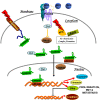Expression analysis of E-cadherin, Slug and GSK3beta in invasive ductal carcinoma of breast
- PMID: 19751508
- PMCID: PMC2753637
- DOI: 10.1186/1471-2407-9-325
Expression analysis of E-cadherin, Slug and GSK3beta in invasive ductal carcinoma of breast
Abstract
Background: Cancer progression is linked to a partially dedifferentiated epithelial cell phenotype. The signaling pathways Wnt, Hedgehog, TGF-beta and Notch have been implicated in experimental and developmental epithelial mesenchymal transition (EMT). Recent findings from our laboratory confirm that active Wnt/beta-catenin signaling is critically involved in invasive ductal carcinomas (IDCs) of breast.
Methods: In the current study, we analyzed the expression patterns and relationships between the key Wnt/beta-catenin signaling components- E-cadherin, Slug and GSK3beta in IDCs of breast.
Results: Of the 98 IDCs analyzed, 53 (54%) showed loss/or reduced membranous staining of E-cadherin in tumor cells. Nuclear accumulation of Slug was observed in 33 (34%) IDCs examined. Loss or reduced level of cytoplasmic GSK3beta expression was observed in 52/98 (53%) cases; while 34/98 (35%) tumors showed nuclear accumulation of GSK3beta. Statistical analysis revealed associations of nuclear Slug expression with loss of membranous E-cadherin (p = 0.001); nuclear beta-catenin (p = 0.001), and cytoplasmic beta-catenin (p = 0.005), suggesting Slug mediated E-cadherin suppression via the activation of Wnt/beta-catenin signaling pathway in IDCs. Our study also demonstrated significant correlation between GSK3beta nuclear localization and tumor grade (p = 0.02), suggesting its association with tumor progression.
Conclusion: The present study for the first time provided the clinical evidence in support of Wnt/beta-catenin signaling upregulation in IDCs and key components of this pathway - E-cadherin, Slug and GSK3beta with beta-catenin in implementing EMT in these cells.
Figures



References
-
- Report of the National Cancer Registry Programme. Ind Council Med Res New Delhi. 2001. p. 22.
-
- Mittra I. Overview of breast cancer in India. European J Cancer. 2006;4(Suppl):180.
Publication types
MeSH terms
Substances
LinkOut - more resources
Full Text Sources
Medical
Research Materials
Miscellaneous

